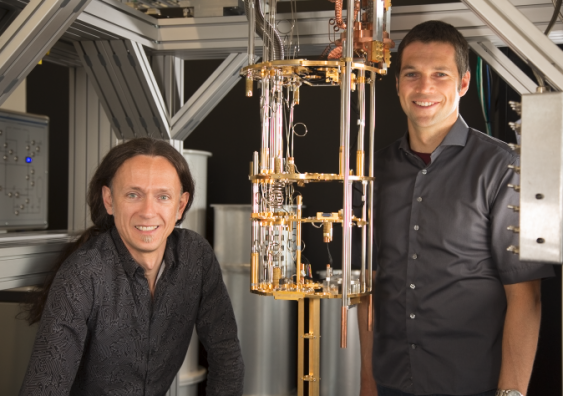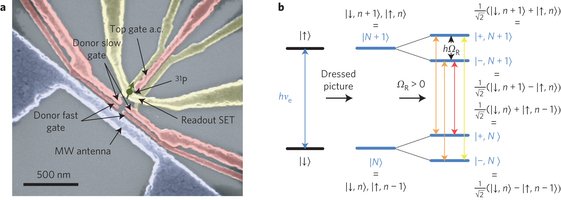Australian scientists have increased the stability of the qubit 10 times
A team of Australian researchers from the University of New South Wales (UNSW) has developed a qubit, which remains in a stable superposition 10 times longer than the previous development. The researchers believe that their new qubit can significantly improve the reliability of quantum computing. The findings are published in the journal Nature Nanotechnology October 17, 2016
Qubits (quantum bits) can have a value of 0 and 1 bits as the standard, but are moving in a superposition state in any state change. New technology developed at the UNSW, called "dressed" qubit. It is not by chance: a qubit represents the spin of one silicon atom surrounded by an electromagnetic field. This feature allows you to store the quantum bit quantum information for longer than "not dressed" atom.
"Dressed" quantum bit - not the first achievement of UNSW in the field of quantum computing: the team has created the most long-lived qubit in a solid state. This is made possible by encoding the information in the quantum spin of one phosphorus atom in the silicon chip, placed in a static magnetic field.
Now scientists have realized a new way of encoding information. They subjected the atom is very strong, constantly oscillating electromagnetic field in the microwave frequency range. The results were striking: since the field varies continuously at a high frequency, any noise or interference on different frequencies mutually subtracted and are reduced to zero. The researchers achieved the result in which the superposition state can hold 10 times longer than before.
All previous qubits are fragile and short-lived. Saving superposition for a long time been one of the main obstacles to the development of quantum computing. However, the research team was able to extend this status to 2.4 milliseconds. During this time, you can make a lot more operations than ever before. Along with this increase, and the time span for which the information is securely stored. Scientists point out that such a result could not be achieved by "not dressed" quantum bit.
Along with information about the expansion of the temporary superposition of frames, the researchers also reported that "dressed qubit" provides greater capacity for manipulation. "Dressed" qubit, in contrast to the "not dressed", controlled in various ways. Andrea Morello, head of the UNSW research team suggests that a quantum bit can be controlled by modulating the frequency of the microwave field as FM-radio. "Not wearing a" qubit, in turn, requires a change of the field amplitude as radio AM.
Perhaps this is why the qubit, surrounded by a magnetic field, is more resistant to noise. Quantum information managed by a frequency that is unchanged, whereas the amplitude can be exposed to external noise. The device is built on a standard silicon technology, it can be used to create powerful and reliable quantum processors. Stages of production will not be different from that used for modern computers.
"Dressed" quantum bit - more versatile and durable than one electron, and this will allow us to create a more robust quantum computers, "- said Arne Lёht. Today UNSW team - a world leader in the development of quantum computing based on silicon. With the participation of Morello's team was able to get $ 70 million Australian dollars (53.5 million US dollars) from researchers, business people and the Australian Government. This amount will be spent on the creation of a prototype of a silicon quantum integrated circuit - the first step in building a quantum computer.
Creating a quantum computer is often called the "space race of the XXI century". In theory, this machine can become a revolutionary tool for calculations, which can not produce any other device. In a conventional computer, all information represented as 0 and 1, whereas the quantum can combine both versions simultaneously. Everything is happening at once, and do not need to sort through a long list of options than, in fact, engaged in "classic" of the device. In a number of key areas: finding information in large and unsorted databases dealing with complex systems of equations and creating just will not be drugs of equal quantum computer.
Quantum computers could quickly develop medication due to accelerated work of computer-aided design of pharmaceutical compounds and reducing testing time. In addition, you can design new, lighter and more durable materials in all areas of production, from consumer electronics to building airplanes.
The first quantum computer, set up in 1998, could manage with only one qubit, while the modern, this figure does not go beyond 16. Scientists predict that the computer was able to solve the problem, the minimum number of qubits must exceed two dozen. A few years ago, the company D-Wave has tried to create a processor with 84 quantum bits, but experts have criticized it, saying that it works exactly the same way as a conventional chip. Now MIT researchers are working on a prototype chip that is able to "lure" the ions trapped in the electric field and to manage them with the help of laser technology.
All that pushes to the conclusion that while the quantum computers are far from practical application. However, their actual potential is undeniable. One day, the computer will be able to quickly and easily perform calculations that take an awful lot of time on classical devices. Already, they pose a threat of asymmetric cryptography.

